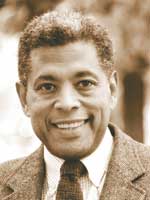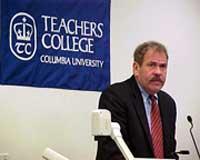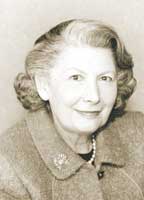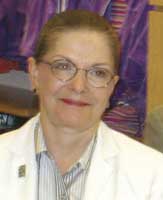| Literacy: Experts Examine Our Nation's
Dilemma [Part I]

Reuel
Jordan
Dean
of Children’s Programs, Bank Street School for Children.
I
would like to offer parents some ideas about how they can
help their children as they develop interest in reading
and writing, and how they can support this development
as their children continue to grow. The support that I
am encouraging is based on three fundamental principles
of the Bank Street School for Children. The first is that
children learn best when their social, emotional and intellectual
development is taken into account as they proceed through
school. Second is that an optimal learning environment
is one where children have active, experiential engagement
with the world around them. The third principle is that
children’s learning is optimized when there is a partnership
between school and home, and the efforts of parents and
teachers are coordinated. By engaging your children actively,
socially, emotionally and intellectually, parents will
nurture the same healthy development we strive for in school.
Providing
a Secure Environment: Emotional development begins
at home. The ways parents speak to their children, play with
them, hold them, and admonish them help to establish children’s
emotional response to the world. An important role for parents
is to help make children feel secure in the world. Simple
things like establishing routines around meals and bedtime
can help children see that the world can be predictable.
Special times like a regular story time at bedtime can ensure
feelings of stability from a caring and loving family.
Encouraging
Active Engagement: Today, parents need to extend themselves
to encourage their children to be actively engaged. When
I was growing up, I had the opportunity to play outside with
the neighborhood kids every day. Handball, bike riding, multiple
variations of tag, kickball, basketball, and stick ball filled
my afternoons and weekends under the watchful eye of stay-at-home
parents, or those on swing shifts—sentinels, peering down
from their windows like watchdogs. Today, concerns about
supervision and a lack of play space require most working
parents who want their children to spend time outside to
use weekends and holidays to foster healthy development.
However, just one or two days of activity per week can ensure
a more hardy and energetic child. Children benefit from being
active indoors as well. Regular chores help children organize
their time, sequence their activity, persevere, and be an
active part of the family.
Healthy
emotional development cannot take place without regular interactions
with other people. Unfortunately, children today have one-third
fewer opportunities to interact with others than they did forty
years ago. Parents can help counteract this phenomenon by having
regular face-to-face discussions at the dinner table. There,
children can learn to express themselves clearly, and, equally
important, learn to listen. Parents who read to and talk to
their children give them a real advantage. Another vitally
important way to nurture intellectual development is to expose
children to new experiences so that their understanding and
curiosity about the world expands. Trips to the museum, the
zoo, outings in nature and the library all help children broaden
their perspective.
Given
this framework in fostering the three components of a developing
child, we can see how parents can support their child’s literacy
development, and suggest how they can coordinate their efforts
with the school.
Making
Reading Fun: The key to effective parent support of the
school’s literacy program is that the activities at home
should not be perceived as a burden, but rather as part of
normal family routines. The idea is to make reading and writing
something that the entire family is interested in and employs
in their normal daily activities. Most importantly, children
should see parents engaged in reading for information and
pleasure. Parents should be models for the behavior that
they wish their children to emulate.
Reading
to young children is the primary and most effective pre-literacy
activity parents can perform. Reading becomes an even more
pleasurable activity when children can sit on a parent’s lap.
While reading, parents can point out key aspects of a book,
like its title, who wrote the book, letters in children’s names.
They can also point out characters. Children can guess with
their parents what will happen next. Children can learn the
value of writing by composing notes to a parent who is at work,
helping to make shopping lists, or creating lists on shopping
trips. The key is that the activity is pleasurable and seen
as an authentic activity for children.
Helping
Older Children Love Reading: Parents of middle school
children can help their children in a number of different
ways. Middle school children are not too old to be read to
either before bed or at some other regularly scheduled time.
As part of this activity, parents can ask their children
to summarize what was read the night before as a way of helping
children develop their concept of story. As children begin
to read on their own, parents can also engage children in
what they are reading. Parents can keep abreast of the book
by reading it themselves or through “read aloud” sessions
where both child and parent take turns reading. Besides summarizing
the plot, parents and children can make predictions about
what will happen next and how they think that the characters
in the book feel about the events. Parents can support writing
by having children write as part of their normal home routine.
Writing thank-you notes, notes on birthday cards, or keeping
a diary are all authentic ways that children can regularly
engage in writing at home.
The
connection between school and home is important in the education
of children. Parents who understand the three components of
child development can make choices at home that support the
work done at school. Parent support brings cohesiveness to
the educational process and unifies the educational experience
for children.#

Arthur Levine, Ph.D., President
Teachers College, Columbia University
Two
actions stand out for me [regarding literacy]. The first
is insuring universal access to quality early and preschool
education for all children at risk of low literacy achievement.
We know who these youngsters are. They come from homes
and communities characterized by low education levels,
low incomes, and high immigration and isolation rates.
The
second action is providing adequate funding for inner city
and rural school systems. At present, these educational
systems, which house the largest numbers of failing schools
and enroll the highest proportion of students failing to
achieve minimum literacy standards, are funded at far lower
rates than suburban school systems. The result is that
they are unable to attract and retain the best-qualified
teachers; their curriculum materials are dated and inadequate
in number and condition; and their plants are too often
antiquated. The funding I am talking about is not equal
funding. It is adequate funding. The difference is quickly
apparent with regard to hiring teachers.
The
simple fact is that working conditions in the suburbs are
better than in urban public schools and the salaries are
higher as well. Paying equal salaries would not solve the
problem. The only way our cities will be able to compete
for the best teachers, since they cannot make the working
conditions superior to those of the suburbs, is by paying
higher salaries. Until we are willing to make that investment,
we will continue to experience a literacy achievement gap
between our affluent and poor youngsters, between children
of color and whites. Until our society stops talking about
the need for literacy and matches our concern with dollars,
the young people who we have failed in the past, we will
continue to fail in the future.
As
for literacy programs, I am a very big fan of Teachers
College Professor Lucy Calkins Reading and Writing Program,
which is working with several hundred New York City public
schools on enhancing literacy skills. When I first arrived
at Teachers College, a Bronx principal called and asked
if I knew Professor Calkins. I said “not yet.” He said, “You
ought to. She transformed my school.” I can’t tell you
how many teachers and school principals have told me the
same thing over the years.#

Sandra
Priest Rose
Reading
Consultant & Founding Trustee of Reading Reform Foundation.
We
at Reading Reform Foundation have sharpened our pencils,
purchased paper and chalk and are ready for the new school
year. We are excited about and committed to supporting
all the changes emanating from the New York City Department
of Education. Our 25 training consultants will be in 56
regular classrooms, helping to provide a foundation for
the new initiatives. We’ll be teaching the sounds of the
language with their appropriate letter symbols from the
beginning. We’ll be helping students to understand what
they are reading. We’ll be teaching students to write clear
sentences, paragraphs and compositions.
As
soon as the child learns a few letter sounds, he or she
can immediately put them into words. Simultaneously writing
and sounding out simple words first, and more complicated
ones later, helps the child fix in his mind what is being
taught, while reinforcing eye training. Children’s eyes
have to be trained to go in the direction in which we read
and write in English. This careful training helps prevent
reading, writing and spelling reversals. Accurate spelling
is important both for good comprehension and because inaccurate
spelling imprints itself on the brain and is hard to correct.
Once
the students understand the idea that letters stand for
sounds and these sounds make up most of the words in our
language in a predictable way, and they are at ease sounding
out words independently, then directing them to comprehend
what they are reading in a thoughtful way is appropriate.
Here the elements of different types of writing (fiction,
non-fiction), elements of stories (character, plot, conflict)
and appreciation of beautiful writing all have an important
place in a reading program.
A
good writing program can also be started early by beginning
with writing simple declarative sentences, moving to paragraphs
and then to compositions, teaching the structural elements
of each. Writing helps clarify thought in subject matter
that interests the student most or can allow expressions
of deepest feelings and concerns.
We
might not have bought new clothes and book-bags but we
are eager to meet the wonderful teachers and students of
2003-2004!#
www.readingreformny.org 
Jerrold Ross, Ph.D., Dean of Education
St. John's University
I
feel literacy will not increase nationally until teachers,
themselves, are more culturally literate. When was the last
time the subject of conversation in a teachers’ room focused
on the latest best seller, Broadway’s most popular new play,
one of the Met’s blockbuster exhibitions, a ballet by any company
in the City? The current controversy over required curriculum
materials in reading would be far less so if teachers were
able to draw on a fund of information they themselves possessed
to make the dreary “teach to the test” approach demanded
by this curriculum more exciting for children. Any text is
only
a supplement to the life experience of the teacher whose
principal task is to communicate the excitement and the literature
or
artifacts of that life experience to students.
Schools
of Education must support a strong liberal arts program for
prospective as well as current teachers. Education professors
must demand as much literate writing from their own students
as a conscientious English professor expects. Required texts
must be supplemented by required additional readings and experiences
that will help to illuminate the facts students are learning
from texts and curricular materials that focus only on testing
expectations.
While
a difficult job, it can be done. Certainly in the New York
City schools I attended, reading real books and most of all
field trips to develop the skills of understanding and communicating
were all accomplished.
There
was even a place for phonics and no one fussed over it. But
this was successfully done by accomplished teachers.
At
St. John’s University every freshman is required to take an
experiential course in “Discovering New York.” Taught largely
by full-time faculty members, many of them seniors, this course
introduces them to the treasures of the city and, thereby,
helps to set a pattern of life-long interest in arts and letters,
the determinant of a literate person who, in turn, can teach “literacy.”#

Edward
Zigler, Ph.D.
Sterling
Professor of Psychology
Yale University, Planner of the Head Start program.
Of
late there have been criticisms that Head Start is not
doing a very good job teaching literacy to its young students.
The ability to read is absolutely essential for an individual
to have a successful life. However, as someone who has
studied the growth and development of children for some
45 years, it is my responsibility to point out that reading
is just one aspect of cognitive development, and that cognitive
development is just one aspect of human development. Cognitive
skills are of course very important, but they are so intertwined
with the physical, social, and emotional systems that it
is myopic, if not futile, to dwell on the intellect and
exclude its partners.
Think
about what goes into literacy. It involves mastery of the alphabet,
phonemes, and other basic word skills. But a prerequisite to
achieving mastery is good physical health. The child who is
frequently absent from school because of illness, or who has
vision or hearing problems, will have a difficult time learning
to read. So will children who suffer emotional troubles such
as depression, attention deficits, or posttraumatic stress
disorder. And think about motivation. A child’s curiosity and
belief that he or she can succeed are just as important to
reading as knowing the alphabet. Phonemic instruction by the
most qualified teacher will do little for a child who suffers
from hunger, abuse, or a sense of inferiority.
We
must broaden our understanding of when and where literacy begins.
I’ve heard a lot of preschool teacher bashing lately, but in
reality, literacy begins much earlier than age four. It begins
with the thousands of loving interactions with parents after
an infant is born. It begins as a child develops a sense of
self worth by realizing that his or her accomplishments, whether
they be learning to roll over or to recite the alphabet, are
important to significant others. It begins with sitting in
a safe lap, hearing a familiar bedtime story. Eventually the
child will want to emulate the parent and read too.
Do
I believe that Head Start should do more to promote literacy?
Most definitely. The new performance standards are moving the
program toward more defined curricula with specific goals for
literacy and related skills. Head Start is a model program
whose success in promoting school readiness has fed the movement
toward universal preschool.
In
sum, if we want a nation of readers, we have to look beyond
teaching phonics. We have to look at the whole child, the parents,
and at all of the people and experiences that make up the child’s
early learning environment.#
Excerpts
from testimony given before the U.S. Senate on February 12,
2003.

Dr. Twila C. Liggett, Ph.D.
Eight-time, Emmy award-winning executive producer, educator and
author,
creator of the award-winning PBS series, Reading Rainbow
The
idea of literacy is at the same time complex and simple. Contrary
to popular belief, most kids (not all) learn, relatively easily,
how to read. (For example, the recent National Assessment of
Educational Progress report states that the average reading
score of 4th grade students has risen since 1994.) Unfortunately,
what much of the research does not reveal is whether these
kids still love to read. It is my observation that even at
a young age and paradoxically, when they still love to be read
to, far too often children don’t choose, nor want, to read
books on their own. In fact, there is a term for this phenomenon,
literacy.
How
does one spark and feed the joy of reading which is my view
of true literacy?
In
1980 when I first began to think about how to take this message
to children in a major way, I focused on the use of a pervasive
medium television as a tool to promote, indeed, to star wonderful
books that kids would ask for, enjoy, come to love and want
to read for themselves!
Evaluation,
research studies and personal letters have confirmed that Reading
Rainbow has been wildly successful in leading kids to great
books plus igniting their curiosity, learning and understanding
of ideas and cultures. Our Reading Rainbow graduates, send
us emails, phone calls and offers of help to keep the series
alive, because in the word of one 20 something entrepreneur,
Reading Rainbow inspired me to develop creative and positive
products for kids and I still love to read!
Literacy
is far too often defined as passing tests and reading required
school texts, most of which are very poorly written. This is
much too limited a view. Rather, literacy is a thirst for knowledge,
fueled by books and learning from every possible medium including
television and the Internet. Literacy and a love of reading
start at day one when kids are read to, the printed and spoken
word predominate at home and parents themselves share their
own love of reading with their children.
Finally,
every Reading Rainbow episode demonstrates to parents and teachers
a way to give children the wonderful gift of loving to read.
Starting with the reading of a great picture book and then
exploring the ideas generated by the book, for example going
to a museum to find out more about dinosaurs, and finally finding
more books to share with other kids is a sure fire way to get
kids excited about reading.
As
a former teacher and reading consultant, I have watched several
decades of various reading programs and policies come and go.
And, more than ever I am not convinced that a national curriculum
and mandated tests will result in a more literate citizenry.
I am convinced, however, that loving to read is the path to
lifelong literacy and that is the mission we at Reading Rainbow
are happily dedicated to.#

Education
Update, Inc., P.O. Box 1588, New York, NY 10159.
Tel: (212) 477-5600. Fax: (212) 477-5893. Email: ednews1@aol.com.
All material is copyrighted and may not be printed without express consent of
the publisher. © 2003.
|
